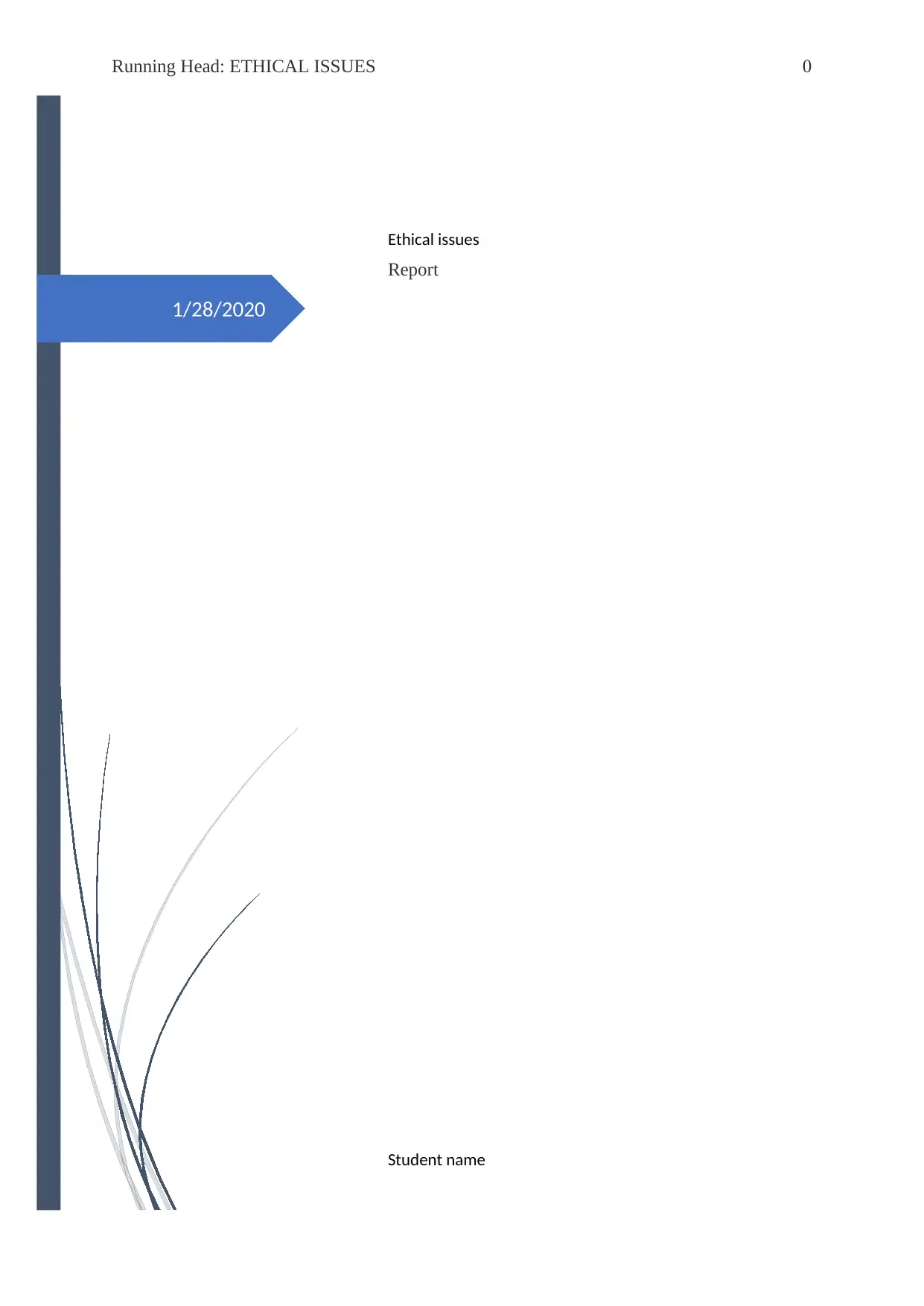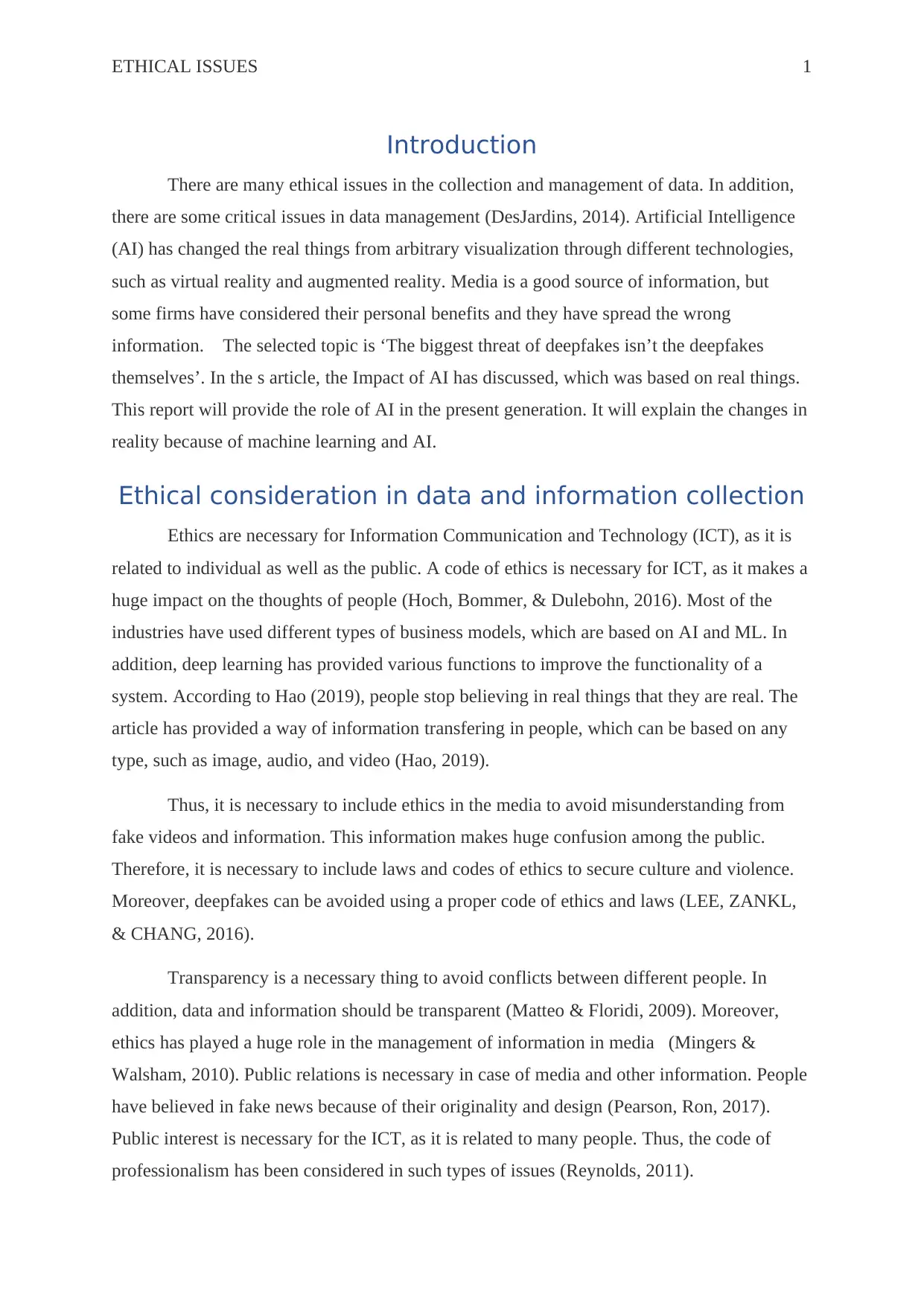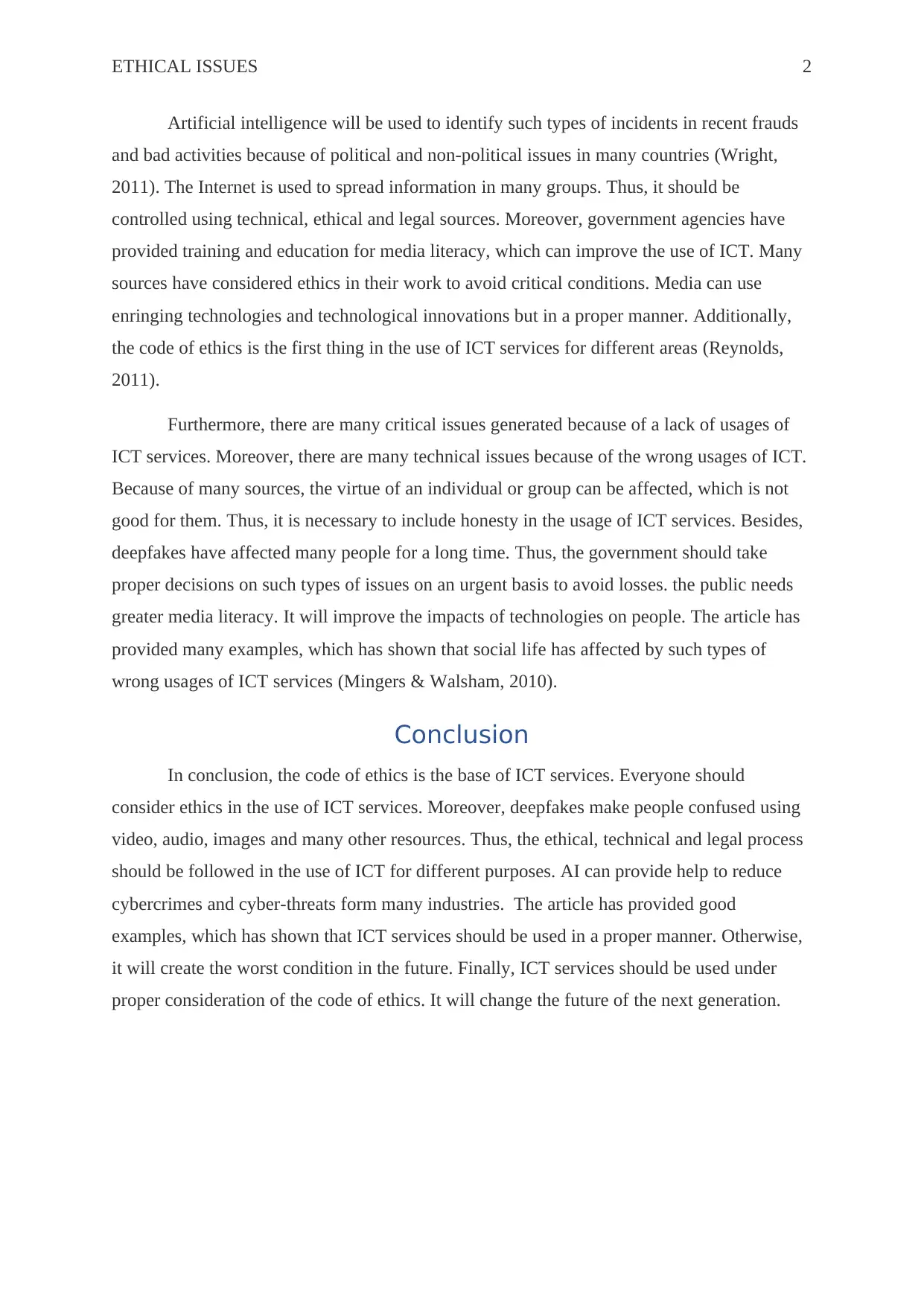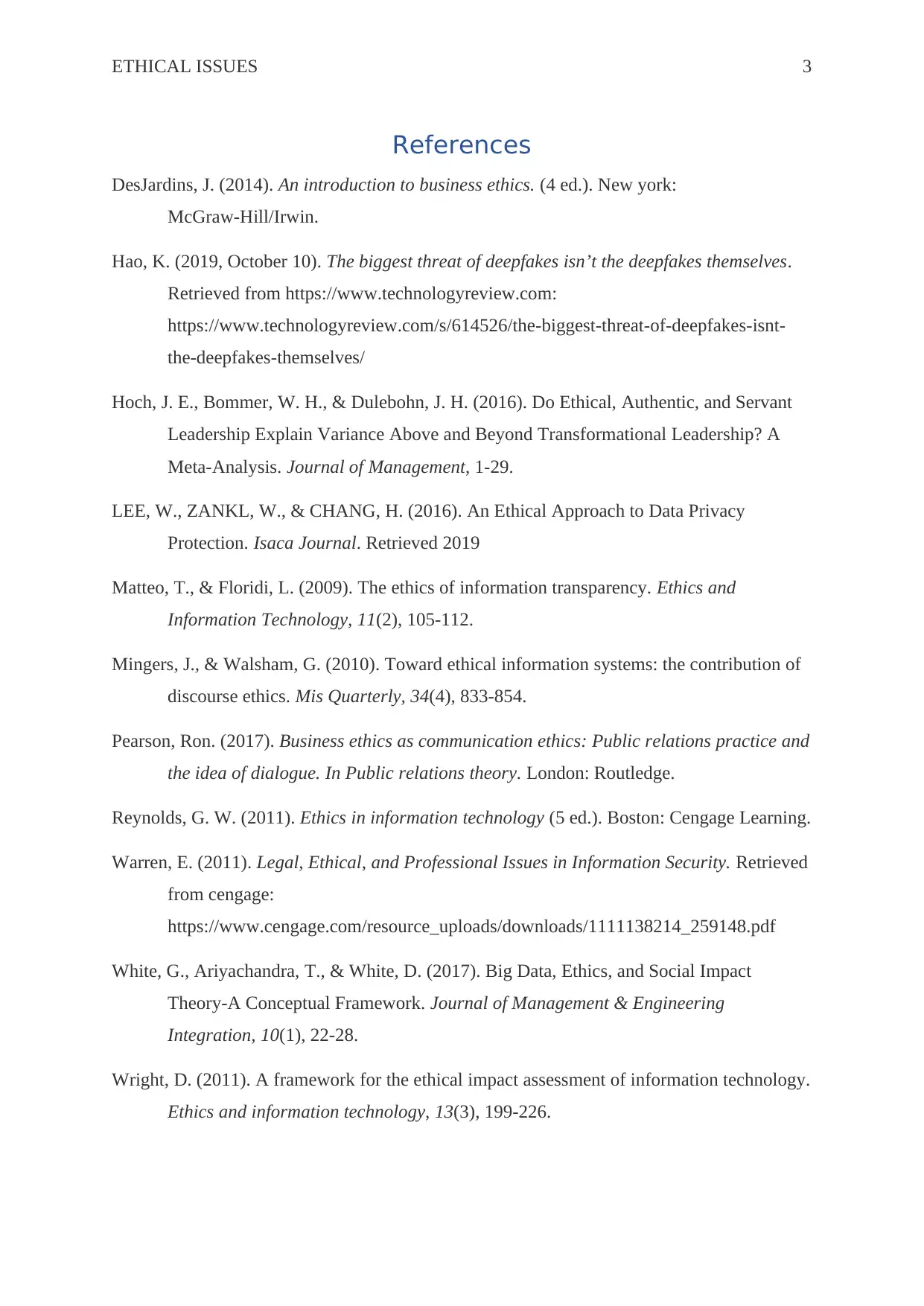Ethical Issues in AI: Data Collection, Deepfakes, and ICT Services
VerifiedAdded on 2022/08/20
|5
|1270
|13
Report
AI Summary
This report delves into the ethical issues surrounding the collection and management of data, particularly in the context of Artificial Intelligence (AI). It explores the impact of AI on various technologies and the spread of misinformation, focusing on the challenges posed by deepfakes. The report emphasizes the importance of ethical considerations in Information and Communication Technology (ICT), highlighting the need for codes of ethics and transparency to mitigate risks and prevent misuse of information. It discusses the role of AI in identifying and addressing cybercrimes, and the need for media literacy and government regulations to ensure responsible use of ICT services. The conclusion stresses the importance of ethical practices in AI and ICT for the future, urging adherence to ethical, technical, and legal processes to safeguard against potential harms.

1/28/2020
Running Head: ETHICAL ISSUES 0
Ethical issues
Report
Student name
Running Head: ETHICAL ISSUES 0
Ethical issues
Report
Student name
Paraphrase This Document
Need a fresh take? Get an instant paraphrase of this document with our AI Paraphraser

ETHICAL ISSUES 1
Introduction
There are many ethical issues in the collection and management of data. In addition,
there are some critical issues in data management (DesJardins, 2014). Artificial Intelligence
(AI) has changed the real things from arbitrary visualization through different technologies,
such as virtual reality and augmented reality. Media is a good source of information, but
some firms have considered their personal benefits and they have spread the wrong
information. The selected topic is ‘The biggest threat of deepfakes isn’t the deepfakes
themselves’. In the s article, the Impact of AI has discussed, which was based on real things.
This report will provide the role of AI in the present generation. It will explain the changes in
reality because of machine learning and AI.
Ethical consideration in data and information collection
Ethics are necessary for Information Communication and Technology (ICT), as it is
related to individual as well as the public. A code of ethics is necessary for ICT, as it makes a
huge impact on the thoughts of people (Hoch, Bommer, & Dulebohn, 2016). Most of the
industries have used different types of business models, which are based on AI and ML. In
addition, deep learning has provided various functions to improve the functionality of a
system. According to Hao (2019), people stop believing in real things that they are real. The
article has provided a way of information transfering in people, which can be based on any
type, such as image, audio, and video (Hao, 2019).
Thus, it is necessary to include ethics in the media to avoid misunderstanding from
fake videos and information. This information makes huge confusion among the public.
Therefore, it is necessary to include laws and codes of ethics to secure culture and violence.
Moreover, deepfakes can be avoided using a proper code of ethics and laws (LEE, ZANKL,
& CHANG, 2016).
Transparency is a necessary thing to avoid conflicts between different people. In
addition, data and information should be transparent (Matteo & Floridi, 2009). Moreover,
ethics has played a huge role in the management of information in media (Mingers &
Walsham, 2010). Public relations is necessary in case of media and other information. People
have believed in fake news because of their originality and design (Pearson, Ron, 2017).
Public interest is necessary for the ICT, as it is related to many people. Thus, the code of
professionalism has been considered in such types of issues (Reynolds, 2011).
Introduction
There are many ethical issues in the collection and management of data. In addition,
there are some critical issues in data management (DesJardins, 2014). Artificial Intelligence
(AI) has changed the real things from arbitrary visualization through different technologies,
such as virtual reality and augmented reality. Media is a good source of information, but
some firms have considered their personal benefits and they have spread the wrong
information. The selected topic is ‘The biggest threat of deepfakes isn’t the deepfakes
themselves’. In the s article, the Impact of AI has discussed, which was based on real things.
This report will provide the role of AI in the present generation. It will explain the changes in
reality because of machine learning and AI.
Ethical consideration in data and information collection
Ethics are necessary for Information Communication and Technology (ICT), as it is
related to individual as well as the public. A code of ethics is necessary for ICT, as it makes a
huge impact on the thoughts of people (Hoch, Bommer, & Dulebohn, 2016). Most of the
industries have used different types of business models, which are based on AI and ML. In
addition, deep learning has provided various functions to improve the functionality of a
system. According to Hao (2019), people stop believing in real things that they are real. The
article has provided a way of information transfering in people, which can be based on any
type, such as image, audio, and video (Hao, 2019).
Thus, it is necessary to include ethics in the media to avoid misunderstanding from
fake videos and information. This information makes huge confusion among the public.
Therefore, it is necessary to include laws and codes of ethics to secure culture and violence.
Moreover, deepfakes can be avoided using a proper code of ethics and laws (LEE, ZANKL,
& CHANG, 2016).
Transparency is a necessary thing to avoid conflicts between different people. In
addition, data and information should be transparent (Matteo & Floridi, 2009). Moreover,
ethics has played a huge role in the management of information in media (Mingers &
Walsham, 2010). Public relations is necessary in case of media and other information. People
have believed in fake news because of their originality and design (Pearson, Ron, 2017).
Public interest is necessary for the ICT, as it is related to many people. Thus, the code of
professionalism has been considered in such types of issues (Reynolds, 2011).

ETHICAL ISSUES 2
Artificial intelligence will be used to identify such types of incidents in recent frauds
and bad activities because of political and non-political issues in many countries (Wright,
2011). The Internet is used to spread information in many groups. Thus, it should be
controlled using technical, ethical and legal sources. Moreover, government agencies have
provided training and education for media literacy, which can improve the use of ICT. Many
sources have considered ethics in their work to avoid critical conditions. Media can use
enringing technologies and technological innovations but in a proper manner. Additionally,
the code of ethics is the first thing in the use of ICT services for different areas (Reynolds,
2011).
Furthermore, there are many critical issues generated because of a lack of usages of
ICT services. Moreover, there are many technical issues because of the wrong usages of ICT.
Because of many sources, the virtue of an individual or group can be affected, which is not
good for them. Thus, it is necessary to include honesty in the usage of ICT services. Besides,
deepfakes have affected many people for a long time. Thus, the government should take
proper decisions on such types of issues on an urgent basis to avoid losses. the public needs
greater media literacy. It will improve the impacts of technologies on people. The article has
provided many examples, which has shown that social life has affected by such types of
wrong usages of ICT services (Mingers & Walsham, 2010).
Conclusion
In conclusion, the code of ethics is the base of ICT services. Everyone should
consider ethics in the use of ICT services. Moreover, deepfakes make people confused using
video, audio, images and many other resources. Thus, the ethical, technical and legal process
should be followed in the use of ICT for different purposes. AI can provide help to reduce
cybercrimes and cyber-threats form many industries. The article has provided good
examples, which has shown that ICT services should be used in a proper manner. Otherwise,
it will create the worst condition in the future. Finally, ICT services should be used under
proper consideration of the code of ethics. It will change the future of the next generation.
Artificial intelligence will be used to identify such types of incidents in recent frauds
and bad activities because of political and non-political issues in many countries (Wright,
2011). The Internet is used to spread information in many groups. Thus, it should be
controlled using technical, ethical and legal sources. Moreover, government agencies have
provided training and education for media literacy, which can improve the use of ICT. Many
sources have considered ethics in their work to avoid critical conditions. Media can use
enringing technologies and technological innovations but in a proper manner. Additionally,
the code of ethics is the first thing in the use of ICT services for different areas (Reynolds,
2011).
Furthermore, there are many critical issues generated because of a lack of usages of
ICT services. Moreover, there are many technical issues because of the wrong usages of ICT.
Because of many sources, the virtue of an individual or group can be affected, which is not
good for them. Thus, it is necessary to include honesty in the usage of ICT services. Besides,
deepfakes have affected many people for a long time. Thus, the government should take
proper decisions on such types of issues on an urgent basis to avoid losses. the public needs
greater media literacy. It will improve the impacts of technologies on people. The article has
provided many examples, which has shown that social life has affected by such types of
wrong usages of ICT services (Mingers & Walsham, 2010).
Conclusion
In conclusion, the code of ethics is the base of ICT services. Everyone should
consider ethics in the use of ICT services. Moreover, deepfakes make people confused using
video, audio, images and many other resources. Thus, the ethical, technical and legal process
should be followed in the use of ICT for different purposes. AI can provide help to reduce
cybercrimes and cyber-threats form many industries. The article has provided good
examples, which has shown that ICT services should be used in a proper manner. Otherwise,
it will create the worst condition in the future. Finally, ICT services should be used under
proper consideration of the code of ethics. It will change the future of the next generation.
⊘ This is a preview!⊘
Do you want full access?
Subscribe today to unlock all pages.

Trusted by 1+ million students worldwide

ETHICAL ISSUES 3
References
DesJardins, J. (2014). An introduction to business ethics. (4 ed.). New york:
McGraw-Hill/Irwin.
Hao, K. (2019, October 10). The biggest threat of deepfakes isn’t the deepfakes themselves.
Retrieved from https://www.technologyreview.com:
https://www.technologyreview.com/s/614526/the-biggest-threat-of-deepfakes-isnt-
the-deepfakes-themselves/
Hoch, J. E., Bommer, W. H., & Dulebohn, J. H. (2016). Do Ethical, Authentic, and Servant
Leadership Explain Variance Above and Beyond Transformational Leadership? A
Meta-Analysis. Journal of Management, 1-29.
LEE, W., ZANKL, W., & CHANG, H. (2016). An Ethical Approach to Data Privacy
Protection. Isaca Journal. Retrieved 2019
Matteo, T., & Floridi, L. (2009). The ethics of information transparency. Ethics and
Information Technology, 11(2), 105-112.
Mingers, J., & Walsham, G. (2010). Toward ethical information systems: the contribution of
discourse ethics. Mis Quarterly, 34(4), 833-854.
Pearson, Ron. (2017). Business ethics as communication ethics: Public relations practice and
the idea of dialogue. In Public relations theory. London: Routledge.
Reynolds, G. W. (2011). Ethics in information technology (5 ed.). Boston: Cengage Learning.
Warren, E. (2011). Legal, Ethical, and Professional Issues in Information Security. Retrieved
from cengage:
https://www.cengage.com/resource_uploads/downloads/1111138214_259148.pdf
White, G., Ariyachandra, T., & White, D. (2017). Big Data, Ethics, and Social Impact
Theory-A Conceptual Framework. Journal of Management & Engineering
Integration, 10(1), 22-28.
Wright, D. (2011). A framework for the ethical impact assessment of information technology.
Ethics and information technology, 13(3), 199-226.
References
DesJardins, J. (2014). An introduction to business ethics. (4 ed.). New york:
McGraw-Hill/Irwin.
Hao, K. (2019, October 10). The biggest threat of deepfakes isn’t the deepfakes themselves.
Retrieved from https://www.technologyreview.com:
https://www.technologyreview.com/s/614526/the-biggest-threat-of-deepfakes-isnt-
the-deepfakes-themselves/
Hoch, J. E., Bommer, W. H., & Dulebohn, J. H. (2016). Do Ethical, Authentic, and Servant
Leadership Explain Variance Above and Beyond Transformational Leadership? A
Meta-Analysis. Journal of Management, 1-29.
LEE, W., ZANKL, W., & CHANG, H. (2016). An Ethical Approach to Data Privacy
Protection. Isaca Journal. Retrieved 2019
Matteo, T., & Floridi, L. (2009). The ethics of information transparency. Ethics and
Information Technology, 11(2), 105-112.
Mingers, J., & Walsham, G. (2010). Toward ethical information systems: the contribution of
discourse ethics. Mis Quarterly, 34(4), 833-854.
Pearson, Ron. (2017). Business ethics as communication ethics: Public relations practice and
the idea of dialogue. In Public relations theory. London: Routledge.
Reynolds, G. W. (2011). Ethics in information technology (5 ed.). Boston: Cengage Learning.
Warren, E. (2011). Legal, Ethical, and Professional Issues in Information Security. Retrieved
from cengage:
https://www.cengage.com/resource_uploads/downloads/1111138214_259148.pdf
White, G., Ariyachandra, T., & White, D. (2017). Big Data, Ethics, and Social Impact
Theory-A Conceptual Framework. Journal of Management & Engineering
Integration, 10(1), 22-28.
Wright, D. (2011). A framework for the ethical impact assessment of information technology.
Ethics and information technology, 13(3), 199-226.
Paraphrase This Document
Need a fresh take? Get an instant paraphrase of this document with our AI Paraphraser

ETHICAL ISSUES 4
1 out of 5
Related Documents
Your All-in-One AI-Powered Toolkit for Academic Success.
+13062052269
info@desklib.com
Available 24*7 on WhatsApp / Email
![[object Object]](/_next/static/media/star-bottom.7253800d.svg)
Unlock your academic potential
Copyright © 2020–2025 A2Z Services. All Rights Reserved. Developed and managed by ZUCOL.





